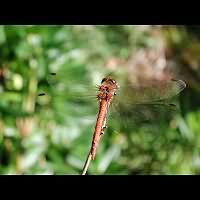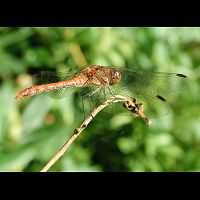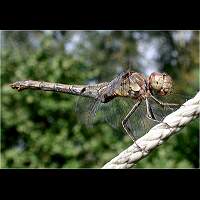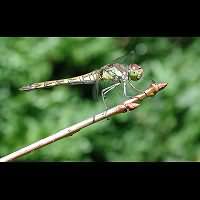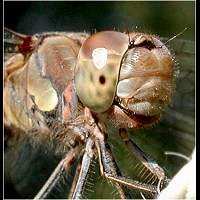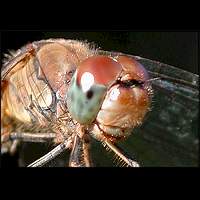[All pictures of garden wildlife on this page are thumbnails. Click on any thumbnail for a large format to be displayed.]
Common Darter (Sympetrum striolatum)
The Common Darter is the most common species in Britain. It is very similar to the very rare Vagrant Darter. Another look-a-like is the Ruddy Darter. The differences between the Ruddy Darter and the Common Darter are much more obvious though. The Common Darter has legs which are partly yellow and partly black. The Ruddy Darter however has black legs. The males are brightly red and have a red face. Females are more difficult difficult to tell apart, but usually the legs will do the trick. The Common Darter will reach a length of some 42 to 45mm, reaching a wing span of some 55 to 65mm.
After mating the first eggs are deposited in tandem position. But after a few minutes the male lets go off the female. She continues depositing eggs alone, but he's never far away chasing off other males. The eggs are usually laid in the mud in very shallow waters, or on the surface of deeper waters, where they soon sink to the bottom. The larvae live in all kinds of water, usually on the bottom or among water plants. Often one of the first species appearing in new waters. Adults always appear after just one year.
The adults of the Common Darter migrate over large areas and are often seen in meadows, roads and gardens far away from water. Just like the Broad-bodied Chaser they usually hunt from a high point. After the attempt to catch a prey, they return to their beloved look-out, either on the look out for a new animal to hunt after, or chewing on the freshly caught prey. Thus they are easily photographed, as you only have to wait a short time for their return. Once used to your presence they often behave like well educated models, even though the males tend to be more restless. The Common Darter deserves its name, for it is abundant in England, Wales and Ireland, common in Southern Scotland, but getting rarer going northwards.
After mating the first eggs are deposited in tandem position. But after a few minutes the male lets go off the female. She continues depositing eggs alone, but he's never far away chasing off other males. The eggs are usually laid in the mud in very shallow waters, or on the surface of deeper waters, where they soon sink to the bottom. The larvae live in all kinds of water, usually on the bottom or among water plants. Often one of the first species appearing in new waters. Adults always appear after just one year.
The adults of the Common Darter migrate over large areas and are often seen in meadows, roads and gardens far away from water. Just like the Broad-bodied Chaser they usually hunt from a high point. After the attempt to catch a prey, they return to their beloved look-out, either on the look out for a new animal to hunt after, or chewing on the freshly caught prey. Thus they are easily photographed, as you only have to wait a short time for their return. Once used to your presence they often behave like well educated models, even though the males tend to be more restless. The Common Darter deserves its name, for it is abundant in England, Wales and Ireland, common in Southern Scotland, but getting rarer going northwards.

© Copyright 1998-2024 gardensafari.net (Hania Berdys)

 English / engels
English / engels  Dutch / nederlands
Dutch / nederlands